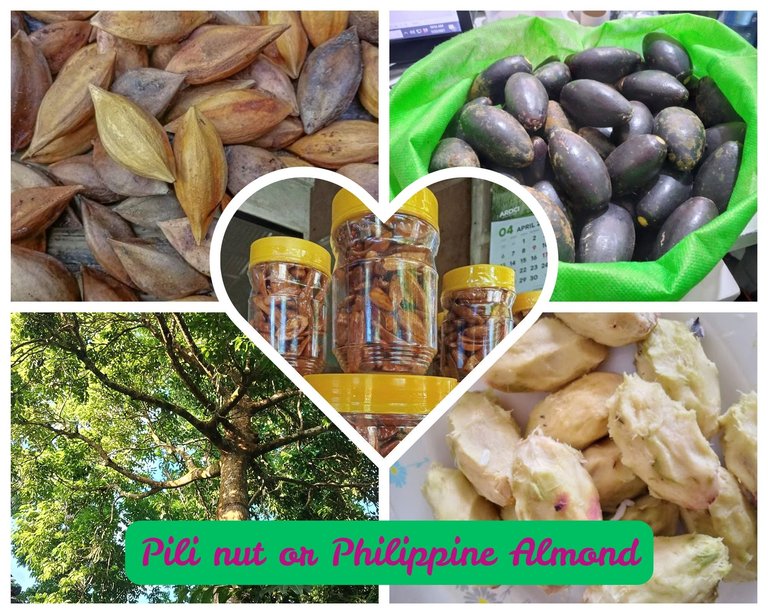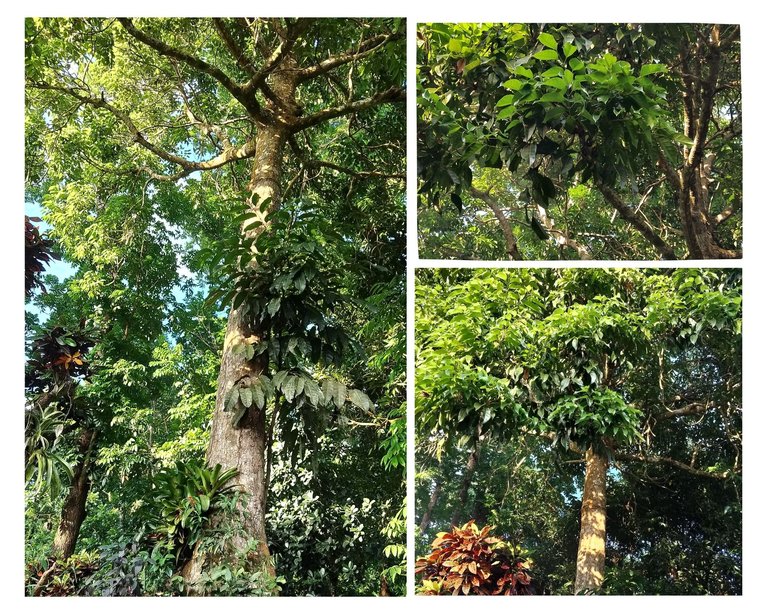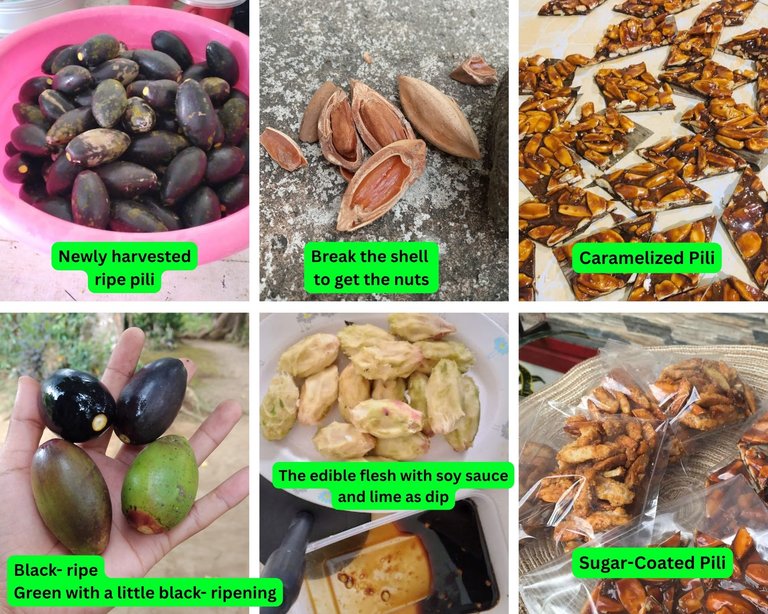THE PHILIPPINES' GIFT TO THE WORLD: The Golden Kernel of the Native Pili Tree
Hello, my dear hive gardeners here at @hivegarden! This month, we are experiencing balanced weather in the Philippines, with enough sun and rain. Today, it was sunny in the morning and rainy in the afternoon, so our plants are really enjoying the nourishment. Here I am again, really excited to participate in the Hive Garden Question of the Week.
This week’s prompt is about Global Gardeners, and I really find it fascinating since I am very interested in other countries’ gardening practices, native plants, and how different cultures grow and care for their green spaces. I want to answer the question: What do you grow in your garden that's absolutely particular to your country? So, I would like to introduce to this community and the world our very own Pili tree (Philippine Almond)!

In my province, Sorsogon, Pili trees are more than just crops; they are part of our cultural identity, livelihood, and tradition. Pili nuts or Canarium Ovatum are native to the Philippines and grow abundantly in the Bicol region. Aside from the tropical climate, it is claimed that Pili trees love the volcanic soil in my region since we have a total of 12 volcanoes, where four of them are active, including Bulusan volcano in Sorsogon and Mayon Volcano in Albay.
My province is considered to be the biggest producer of quality pili nuts in the world, and I am proud of that. In fact, Pili Festival is being held in the province’s capital, Sorsogon City, every year to feature its unique pili products.

This big Pili tree is just in front of our house. I guess it’s more than three decades old now. It was still small when I was a kid, and we played around it, hanging on its boughs.
Its branches are firm and flexible, capable of withstanding strong winds, which is perfect since our region is one of the most typhoon-hit areas in our country. Aside from this tree in our front yard, we also have around 20 pili trees in our farmland in the nearby village.
Pili nuts are usually harvested when the fruits turn black, but you can also pick them while still green, but not too young, because the nuts inside the shell might not be fully developed.

This is what the fruit looks like. There is an outer skin covering the shell, and inside the shell is the nut, so it’s not easy to get the nuts. We can eat both the fleshy part beneath the outer skin and the nuts inside the shell. We just soak the fruit in lukewarm or slightly warm water to soften it, then we can remove the outermost skin and eat the fleshy part that covers the shell. We often use spicy soy sauce with lime as a dip.
And of course, the most precious things are the kernels inside the shell, which are being exported to different countries. They have buttery textures with rich taste and high nutritional value. These tasty buttery kernels are made into different kinds of treats such as Sugar-Coated Pili, Pili Brittle, Roasted and Caramelized Pili, Pili Pastillas, Pili Tartlets, Pili Mazapan, Pili Conserva, etc. Sorsogon once made the biggest Pili Conserva as a Guinness World Record attempt.
Thanks for reading my story. I’m really enjoying the community’s weekly prompts, and I love reading your entries too.
(Photos are mine, edited in Canva)

Congratulations @shine6712! You have completed the following achievement on the Hive blockchain And have been rewarded with New badge(s)
Your next target is to reach 4000 upvotes.
You can view your badges on your board and compare yourself to others in the Ranking
If you no longer want to receive notifications, reply to this comment with the word
STOPCheck out our last posts:
Thanks for the consistent buzz @hivebuzz 💜
Awesome job @shine6712! Keep pushing yourself and you'll reach your Hive goals before you know it.
This is the first time I see this tree.Maybe I've seen it before but I didn't pay attention.
That's why this question is so right :)
It's a really nice and big Pili tree and I think i should try Pili I need to check if it can be found here..
I'm not sure which part of the world you are in, but I think Pili trees don't like the climate in Europe and other regions with four seasons, but that doesn't mean they can't be cultivated in such places. I heard they grow mostly in Asia, like Indonesia and Malaysia, aside from the Philippines. In America, I heard there are some in Hawaii and maybe in other tropical and subtropical parts of it. I'm not sure if the Amazon forest can be suitable for these trees, perhaps yes, since it's a habitat for various tree and plant species. I really want to know, so I want to hear from other people from different parts of the world. Thanks for sharing your thoughts. I'm excited to know what your place can offer to us and to the world. 🍃💚
I am in Serbia, Southeast Europe. I think it is difficult to grow a tree here. It is a tropical plant.I tried with avocado and that didn't work either.I was diligent, I wrote a post, what is specific to our region :)
I see. But which tree can you grow there? Probably apples and berries?
Yeah, I've read about your Ajvar, it's really amazing. We have a similar pastes and spreads here but as I look at the ingredients and preparation procedure you posted, I confirmed that it's very different.
Yes, apples, pears, apricots, peaches, medlars, cherries, walnuts, quince,
Even Japanese apples grow here, I planted one
And kiwis grow too
Of course, berries grow well here, currants, strawberries, raspberries, blackberries
I personally am struggling with raspberries this year, but blackberries promise us a big harvest.
Now I look at the map, almost 10,000 kilometers to the Philippines, wow
But it's nice when we share recipes, and try to prepare food that is eaten on the other side of the planet
Of course, not only recipes, but also experiences. Gardening connects us in any part of the world, whether we are
Definitely! This platform and this community helps us learn about other cultures, customs, topography, gardeming practices, recipes and a lot more, isn't it amazing?! Loving how it connects people that are miles away from us in just seconds. Imagine almost 10,000 kilometers away but we are able to share how Serbians make their secial Ajvar and you also learned about our Pili tree and Pili nuts!
Oh, did we forget that we are in the digital era? Hehe! it's just amazing to learn your ptactices over there.
Trust me, I sometimes forget what time it is and what day it is in the garden
Which is good, to switch off sometimes :)
Wow! This is very interesting and inspiring post. Now I learned about Pili tree and how important it is in your place. I love how you shared your story. From your childhood memories to how to prepare and eat the fruit. You made me want to try Pili Nuts someday.
Thanks for stopping by. It's nice to hear that you learned something and want to try pili nuts. You may try to grow pili trees in your backyard.
Oh goodness, as much as I'd like to reward you every week, I think this week we better give someone else a chance, haha! But this post is SO good - wow! You always share such interesting things about the Philipines, and things I haven't heard of of. REally interesting thanks soooo much for sharing!
Thanks so much for your contribution to the #hivegardenQOTW. The community appreciates your insights, inspiration & engagement with all of us in the Hive Garden!
The HIVE GARDEN COMMUNITY supports gardening, homesteading, cannabis growers, permaculture and other garden or botanical related content. Delegations to the curation account, @gardenhive, are welcome! Find our community here!
Oh, absolutely! 😊 I truly believe in giving others a chance 💖
I just found the question so fascinating that I felt inspired to share my thoughts. I really love sharing about my place in this wonderful community—it means a lot to me. Thank you so much for your kind words and appreciation! It genuinely warms my heart. 💝😊